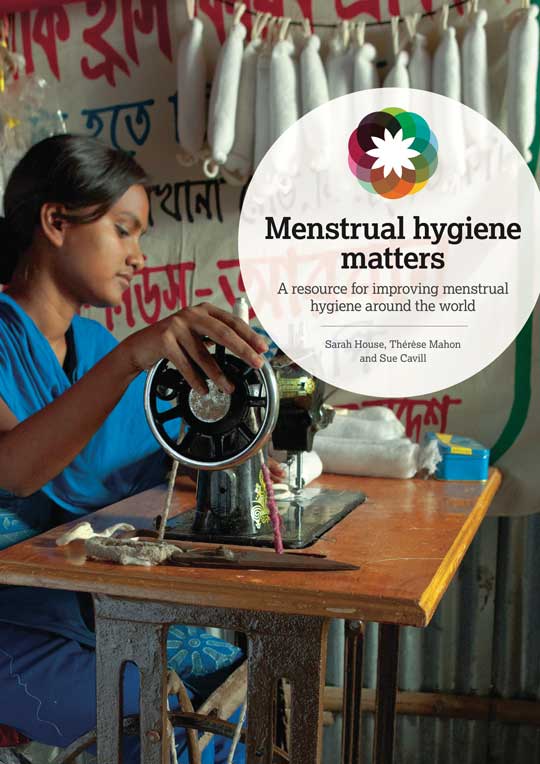Menstrual hygiene in education and in emergencies
Su Corcoran
At EENET we get excited by new resources that provide practical information about how people are implementing inclusive education. Produced at WaterAid, Menstrual Hygiene Matters was designed to document practical experience of promoting menstrual hygiene and its impacts. In this article, Su provides an overview of the context of the resource, and reviews four of the modules developed for use in schools, in emergencies, and in vulnerable, marginalised or special circumstances.
Why should menstrual hygiene be considered?
As Mandu explained in her article on menstrual cups (see pages 28-29), girls and women in many areas of the world struggle to manage their menstruation hygienically, especially in public places such as schools. The taboos that surround menstruation can exclude women and girls from many aspects of social and cultural life. As 52% of the female population (about 26% of the total global population) are of reproductive age, and menstruate regularly, the impact of not taking menstruation seriously is a big problem.
For example, where women and girls lack involvement in decision-making, menstruation can be a forbidden topic. This means that girls grow up with limited information about biological facts or good hygienic practices. They often lack access to appropriate sanitary products and the means to wash or dispose of them. Taboos around menstruation can lead to women and girls being excluded for the days on which they menstruate: they are denied access to the home, shared or public facilities, and water. Schools in many developing countries often do not provide female students or teachers with facilities for managing menstrual hygiene. Girls can miss quite a bit of school or drop out completely.
In emergencies, the usual coping strategies for managing menstruation may be disrupted, particularly when girls and women are displaced and have left clothes, sanitary products and soap behind. They may not necessarily have access to their own finances with which to buy replacements. Living in refugee camps and other areas where they are in close proximity to men and boys (both relatives and strangers) makes privacy difficult. Water sources may be limited and dangerous to access. In conflict situations, water sources are often targeted with landmines.

WaterAid’s menstrual hygiene resource
WaterAid aimed to provide a comprehensive resource offering context-specific information for improving practices for women and girls. It comprises nine modules and associated toolkits that focus on specific aspects of menstrual hygiene. The toolkits, depending on the topics being covered, contain activities for the dissemination of the module content, technical designs and specifications, case studies and examples of further information and bibliographies.
Module 1 addresses the basics: what menstruation is; why menstrual hygiene is important for all; girl’s first experiences of menstruation, especially the impact of this happening in school; and the health issues related to menstruation.
The resource is designed to be used as a whole. Each module begins with a table that highlights the sections of other modules that feed into the topic. Here is a brief overview of three modules:
Module 5 – Working with schools on menstrual hygiene
This describes the challenges faced by menstruating girls and women in schools, and the benefits of good menstrual hygiene. The module provides case studies of different school-based programmes in a number of countries. The activities show how to engage different stakeholders in the community: teachers, girls, parents, boys, etc. The module outlines what currently makes a menstrual hygiene-friendly school, but it also highlights the gaps in research and education.
Module 6 – Working in emergencies on menstrual hygiene
This provides an overview of the challenges that are faced by menstruating girls and women in emergencies. It highlights the importance of designing programmes that appropriately consider menstruation needs from the start of an emergency response. The module deals with responses to menstruation when responding to an emergency and in preparing for longer-term contexts. It offers international guidelines and provides detailed examples of practical solutions.
Module 7 – Supporting girls and women in vulnerable, marginalised or special circumstances
This discusses the issues faced by girls and women who are considered vulnerable or marginalised, such as: those living in poverty, those who are homeless, former or current child soldiers, refugees, those who have disabilities, etc. The module highlights the importance of considering the multiple layers of vulnerability that women and girls may experience. It also encourages readers to think about other special circumstances, such as women or girls with fistula, or who have undergone female genital mutilation. Each of the groups listed at the beginning of Module 7 are considered separately, with detailed information on how to support each one. For example, page 157 considers the particular challenges faced by girls and women with developmental disabilities during their menstrual cycle.
Available online
This essential resource outlines gaps in the research, as well as examples of good practice. It considers the diverse contexts within which women and girls in lower and middle income countries have to manage their menstrual hygiene. The resource is available as a 354-page PDF file (in low and high resolution options), or the modules can be downloaded individually from: http://bit.ly/eer5-art25
Su Corcoran is a research consultant and Programme Officer at EENET.
Email: info@eenet.org.uk
